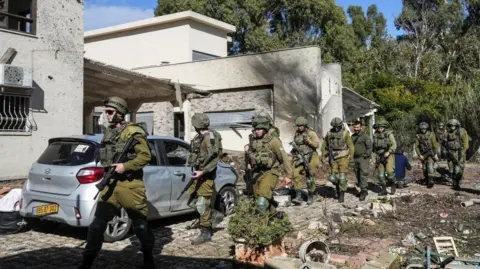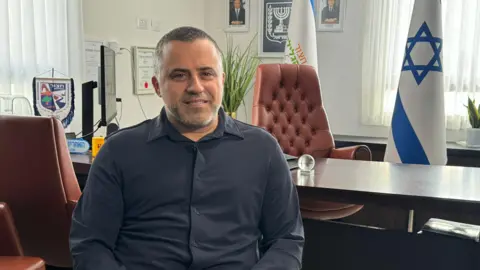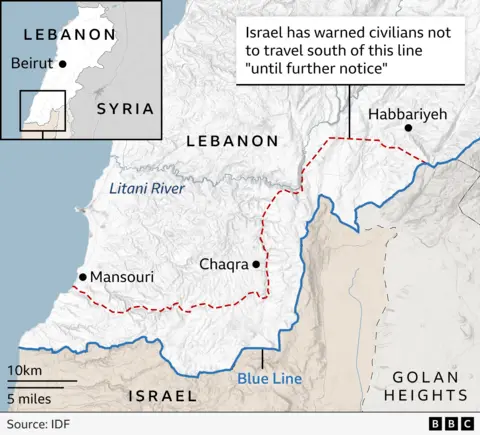 Reuters
ReutersIsrael says its forces fired artillery and carried out airstrikes against targets in southern Lebanon, on the second day of a ceasefire brokered after more than a year of war between Israel and the Lebanese militia group Hezbollah.
The Israeli army said it had fired at suspects after spotting activity at a Hezbollah weapons facility, and vehicles arriving in several areas that breached the terms of the ceasefire deal.
Lebanon accused Israel of violating the agreement “multiple times” and said it was monitoring the situation.
Despite fraying around the edges, so far the ceasefire appears to be largely holding, and the Israeli military road leading to the northern tip of the Lebanese border was sleepier than it has been for months. Through the open gates of bases, soldiers were carrying out routine maintenance, stick figures on the lines of tanks, etched against the late afternoon sky.
One captain, who crossed out of Lebanon this morning, told me he and his team were happy to be out of the fighting and going back to their lives – but that they all hoped they had done enough.
“If not, we all understand that we’ll find ourselves back here soon enough,” he said.
“Personally, I think there’s still work to be done. It’s clear that Hezbollah is still strong enough to threaten Israel.”
Israel’s leaders are signalling their confidence to the public – lifting daily restrictions in some areas, and removing blast walls and makeshift shelters from border roads.
Prime Minister Netanyahu has also vowed an “intensive war” if Hezbollah violates the ceasefire.
There is vocal support from Washington for using this truce as a springboard to a wider regional ceasefire. And Hamas has reportedly signalled its willingness to talk about a deal along similar lines.
But there are many voices here in the north who say the ceasefire with Hezbollah is a mistake, even a “surrender”.

One of them is Michael Kabesa, mayor for the northern community of Hatzor Haglilit.
“It’s more a surrender agreement than a ceasefire,” he told me. “We didn’t finish the job, we stopped at 70% – so they will grow, restore their abilities, and we will meet again in another 20 years.”
The focus on this side of the border is when and how residents might begin to return to communities that were evacuated at the start of the war, almost 14 months ago.
“We need a very safe parameter,” Mayor Kabesa told me. “We need to see the army on the border on a big scale, so it will give us confidence.”
Israeli forces are due to gradually hand over control of southern areas of Lebanon over the next two months, to the Lebanese army, with Unifil support, and oversight from the American military and the French.
“The Americans and the French are a really nice addition,” said Mr Kabesa, “but we know that no power, no international force, can enforce the situation. We need to take care of ourselves – this is the biggest lesson after 7 October.”
The 7 October attacks on Israel last year – carried out by the Palestinian armed group Hamas, a Hezbollah ally in Gaza – have transformed social and political life here.
Mayor Kabesa was among the first Israeli soldiers who helped to clear the ravaged kibbutzim around the Gaza border in the early days after the attack.
What he saw after the Hamas invasion, he said, has changed his assessment of security in the north.

But there are some in these northern communities who have refused to evacuate during almost 14 months of war, staying on in abandoned towns that were regularly hit by Hezbollah rockets and missiles.
Chris Coyle, originally from Edinburgh, is one of only four residents left in his apartment complex in Kiryat Shmona.
All the windows in his block – and those of the buildings 200m around it – are boarded up, after being blown out when a missile landed in the road outside several months ago.
Rockets and missiles landed here several times a day – sometimes several times an hour.
Before Israel sent ground forces into Lebanon to push back Hezbollah positions, Chris had four seconds to get to the safe room – it wasn’t enough, so he used to just lie on the kitchen floor, using the fridge door as a shield.
“We need a ceasefire,” he told me. “If it holds for a month, we can have some hope.”
For the past year, Kiryat Shmona has been a ghostly empty place, scarred by rockets, where lone soldiers buy off-duty supplies from the few shops still open.
But Chris says a ceasefire will bring the town back to life.
“I’ve spoken to a lot of people who have said they’ll come back,” he said. “It’ll take a month or two, but they’ll come back.”
The army captain I met on his way out of Lebanon today said he thought troops had delivered the opportunity for Israel to stop and evaluate the operation.
“I think it’s a good time to give this a chance,” he said. “I hope the politicians will make the best out of it – and also to know when to stop accepting what the other side is doing, and react.”

